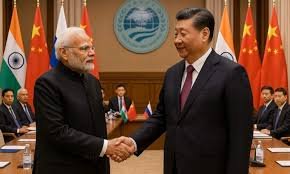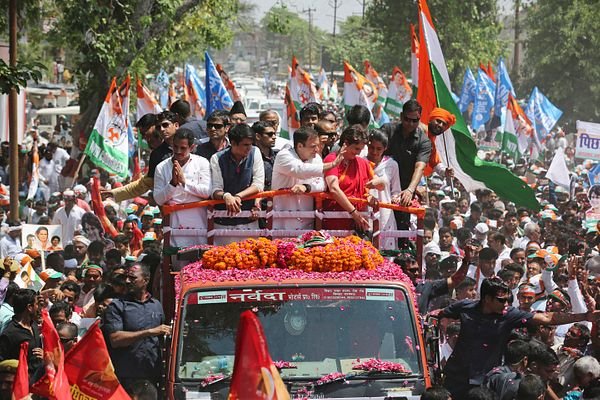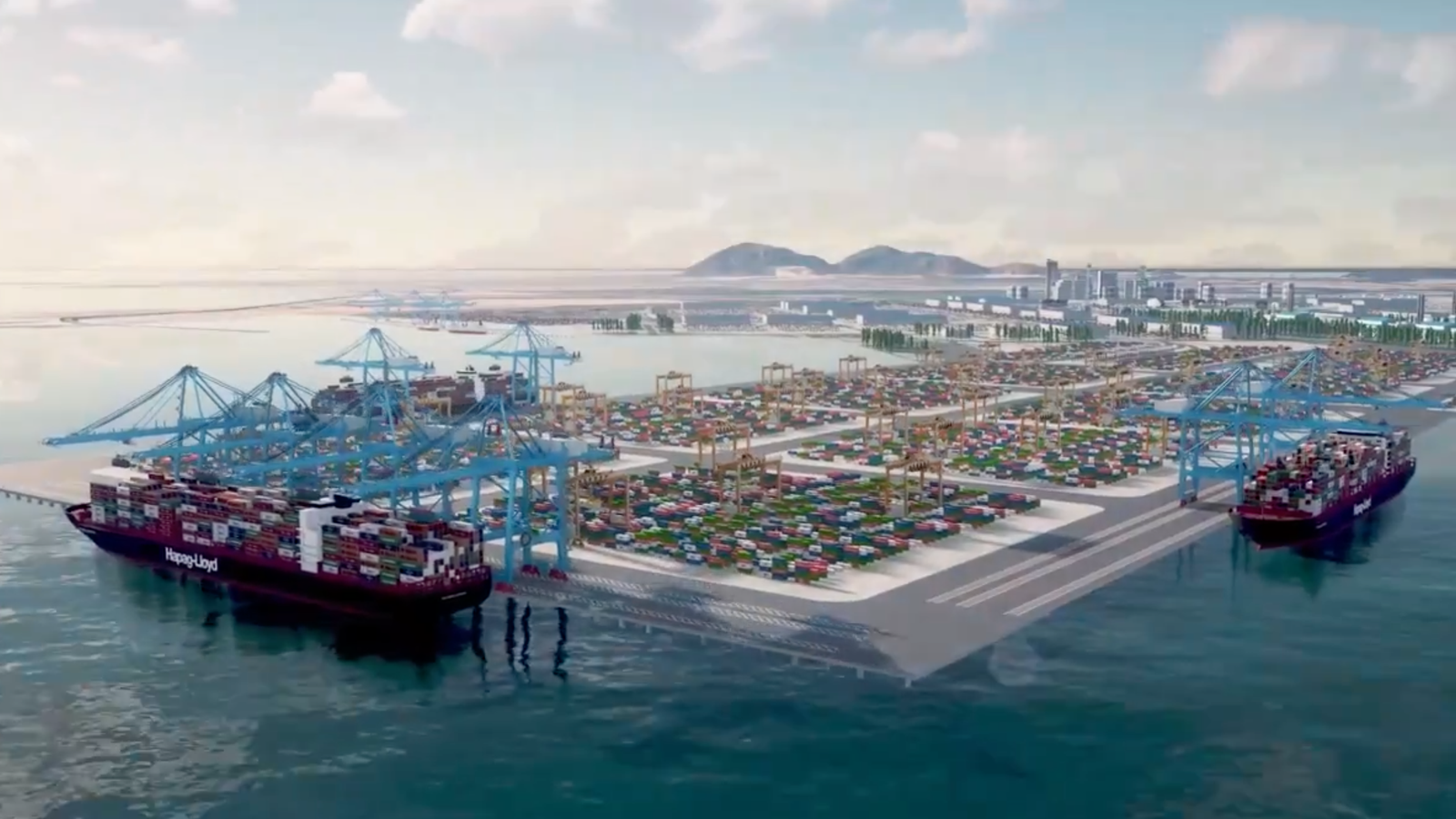Why in the News?
- 2025 marks 75 years of diplomatic relations between China and India (since 1 April 1950).
- Their meeting at the 25th SCO Summit (Tianjin, 2025) focused on stabilising bilateral ties and considered China’s Global Governance Initiative (GGI) to reform how the world handles shared problems.
Key Highlights
- Timeline of India–China Relations (1950–2025)
| Year | Key Events / Developments | Significance / Outcome |
| 1950 | India became one of the first countries to recognise the People’s Republic of China (PRC). | Formal diplomatic relations were established on 1 April 1950, beginning official bilateral engagement. |
| 1954 | Signing of the Panchsheel Agreement (Five Principles of Peaceful Coexistence). | Became the guiding framework for bilateral relations based on mutual respect and non-interference. |
| 1959 | Dalai Lama fled to India after Tibetan uprising. | China viewed India’s asylum offer as interference in its internal affairs, leading to mistrust. |
| 1962 | India–China War over border disputes (Aksai Chin & Arunachal Pradesh). | Major setback; diplomatic ties frozen; India suffered defeat; border issue remains unresolved. |
| 1976 | Restoration of Ambassador-level diplomatic relations. | Marked the slow normalisation of ties after 14 years of limited contact. |
| 1988 | PM Rajiv Gandhi’s visit to China. | Reopened dialogue; both sides agreed to improve political and economic cooperation despite border disputes. |
| 1993 | Signing of the Border Peace and Tranquility Agreement (BPTA). | Institutionalised mechanisms to manage the Line of Actual Control (LAC) peacefully. |
| 1996 | Confidence Building Measures (CBMs) agreement signed. | Introduced measures like troop reduction and advance notification of military exercises. |
| 2003 | PM Atal Bihari Vajpayee’s visit to China. | India recognised Tibet as part of China; both sides agreed to appoint Special Representatives to resolve boundary issues. |
| 2005 | Agreement on Political Parameters and Guiding Principles for boundary settlement. | Provided a framework for future border negotiations. |
| 2008 | India and China signed a Shared Vision for the 21st Century. | Stressed cooperation in multilateral forums and global issues. |
| 2013 | Border Defence Cooperation Agreement (BDCA) signed. | Aimed to prevent border confrontations and enhance communication along the LAC. |
| 2014 | Xi Jinping’s state visit to India (Ahmedabad). | Year declared as “India–China Friendly Exchanges”; focus on trade and investment. |
| 2015 | PM Modi’s visit to China (Xi’an). | Strengthened economic cooperation and cultural exchanges. |
| 2017 | Doklam standoff between Indian and Chinese troops. | Lasted 73 days; de-escalation achieved through diplomatic talks but trust declined. |
| 2018 | Wuhan Informal Summit between Modi and Xi. | Aimed to rebuild trust post-Doklam; agreed on strategic communication and cooperation. |
| 2019 | Chennai Informal Summit (Mamallapuram). | Continued efforts to stabilise ties and manage differences. |
| 2020 | Galwan Valley clash in Ladakh. | First fatal confrontation in decades; relations hit lowest point; border tensions resurfaced. |
| 2021–22 | Series of military commander-level talks. | Partial disengagement achieved in some areas, but overall trust remained low. |
| 2023 | Xi–Modi meeting at BRICS Summit (Johannesburg). | Resumption of leader-level dialogue after COVID and Galwan tensions. |
| 2024 | Xi–Modi bilateral meeting at BRICS Summit (Kazan). | Discussions on stabilising ties and improving communication channels. |
| 2025 | 25th SCO Summit at Tianjin and 75th anniversary of India–China relations. | Xi and Modi’s 19th in-person meeting; focus on cooperation, peace at borders, and China’s Global Governance Initiative (GGI). |
- Long history, recent outreach
- China and India established ties in 1950. Relations have seen cooperation, rivalry and episodes of tension. Leader-level contacts have been central to managing the relationship.
- Intense leader diplomacy (2014–2024)
- Xi and Modi met about 18 times between 2014 and 2024. Notable moments were Xi’s state visit to India (2014) and Modi’s visit to China (2015). They used BRICS, G20 and SCO summits to meet and build trust.
- Pandemic pause and restart
- During COVID years, face-to-face meetings declined but leaders used calls and letters. In 2023 and 2024 they resumed in-person talks (e.g., BRICS sideline meetings in Johannesburg and Kazan).
- Tianjin SCO Summit and the 2025 Modi–Xi meeting
- The 25th SCO Summit (Tianjin) was important because it brought leaders of Eurasian states together. Xi and Modi met in person (their 19th in-person meeting) to discuss bilateral ties, border stability, restoring direct flights and cooperation in the region.
- Global Governance Initiative (GGI) — Xi’s five principles
- China proposed the GGI to improve global governance. Its five simple principles are:
- Sovereign equality — respect for all states’ choices and no external interference.
- International rule of law — uphold the UN Charter and apply rules without double standards.
- China proposed the GGI to improve global governance. Its five simple principles are:
- Multilateralism — major global decisions should involve many countries through bodies like the UN.
- People-centred approach — policies should improve ordinary people’s wellbeing.
- Real results — focus on practical solutions; developed countries should provide more resources, and developing nations should cooperate.
- Why does India–China cooperation matter now?
- Both are large Asian powers with growing global influence. Their practical cooperation can support: regional stability, stronger multilateral institutions, development for Global South countries, and a more balanced international order.
Key Terms
- Multilateralism
- Decision-making by multiple countries through institutions (UN, WTO, IMF, SCO).
- Promotes collective action on cross-border problems like climate, trade and security.
- Challenges include differing interests, power asymmetries and enforcement limits.
- Strengthening multilateralism means making institutions more representative and effective.
- India and China both use multilateral forums to advance shared and national interests.
- Confidence-Building Measures (CBMs)
- Practical steps that reduce mistrust between rivals (hotlines, border protocols, joint patrols, information sharing).
- They lower the chance of accidental clashes and create space for talks.
- CBMs are low-cost but high-impact tools to maintain peace while political solutions are sought.
- For India–China, CBMs have included military meetings, border management talks and limited disengagements.
- Effective CBMs require continuing dialogue and verification mechanisms.
Implications
- Stronger Asian voice in global fora: Joint action by India and China could amplify developing countries’ views at the UN, BRICS and SCO.
- Reduced regional tensions: Regular leader dialogue and CBMs (confidence-building measures) can lower the risk of border flare-ups and protect trade and people-to-people ties.
- Economic opportunities: Cooperation may promote trade, connectivity projects and easier flights — helping businesses and travelers.
- Shift in global governance debates: The GGI pushes for changes that challenge the status quo and call for fairer, more inclusive institutions.
- Practical expectations: The success of summit ideas depends on concrete follow-up — projects, funding, and cooperation on security and development.
Challenges and Way Forward
| Challenge | Way Forward (simple steps) |
| Border mistrust and past clashes | Keep military and diplomatic hotlines active; implement agreed disengagement and border protocols. |
| Different views on global rules | Use UN, SCO and BRICS for dialogue; test reforms through small pilot projects before wider rollout. |
| Economic imbalances and trade tensions | Negotiate market access, investment protections and joint ventures to make trade mutually beneficial. |
| Regional instability (e.g., West/Central Asia) | Coordinate on counter-terrorism, maritime security and humanitarian responses with regional partners. |
| Public scepticism and politics at home | Communicate concrete benefits (jobs, flights, trade) and keep diplomacy transparent to build public support. |
Conclusion
The 2025 Tianjin SCO Summit and the Xi–Modi meeting show a pragmatic effort to stabilise China–India ties and to shape global governance debates. Words alone will not suffice, follow-up on security, trade and multilateral reforms is essential. If both countries deliver practical results, the partnership can benefit Asia and the wider developing world.
| EnsureIAS Mains Question Q. Assess the significance of the 2025 Tianjin SCO Summit and the Xi–Modi interactions for regional stability and global governance. What practical steps should India and China take to translate summit ideas into measurable outcomes? (250 Words) |
| EnsureIAS Prelims Question Q. With reference to the 2025 Tianjin SCO Summit and China–India relations, consider the following statements: 1. China and India established formal diplomatic relations in 1950, making 2025 their 75th anniversary. 2. China’s Global Governance Initiative (GGI) calls for sovereign equality and multilateral decision-making. 3. The SCO Summit is a bilateral forum only for China and India to discuss border issues. 4. Recent India–China talks included restoring direct flights and discussions on border peace. Which of the statements given above are correct? Answer: A. 1, 2 and 4 only Explanation: Statement 1 is Correct: India and China started diplomatic relations on 1 April 1950; hence 2025 marks 75 years of formal ties. This anniversary framed multiple leader interactions and commemorations during 2025. Statement 2 is Correct: The GGI proposed at the Tianjin summit emphasises principles including sovereign equality and stronger multilateralism, urging that global governance involve many countries and respect each nation’s development choices and non-interference. Statement 3 is Incorrect: The Shanghai Cooperation Organisation (SCO) is a multilateral Eurasian forum (including China, India, Russia, Pakistan and Central Asian states). It is not a bilateral China–India platform; it addresses regional security, economic and political issues among all members. Statement 4 is Correct: Xi–Modi discussions around the 2025 SCO touched on practical items such as maintaining peace at border areas and resuming direct flights, indicating a focus on normalising ties and improving connectivity. |
| Also Read | |
| UPSC Foundation Course | UPSC Daily Current Affairs |
| UPSC Monthly Magazine | CSAT Foundation Course |
| Free MCQs for UPSC Prelims | UPSC Test Series |
| Best IAS Coaching in Delhi | Our Booklist |





